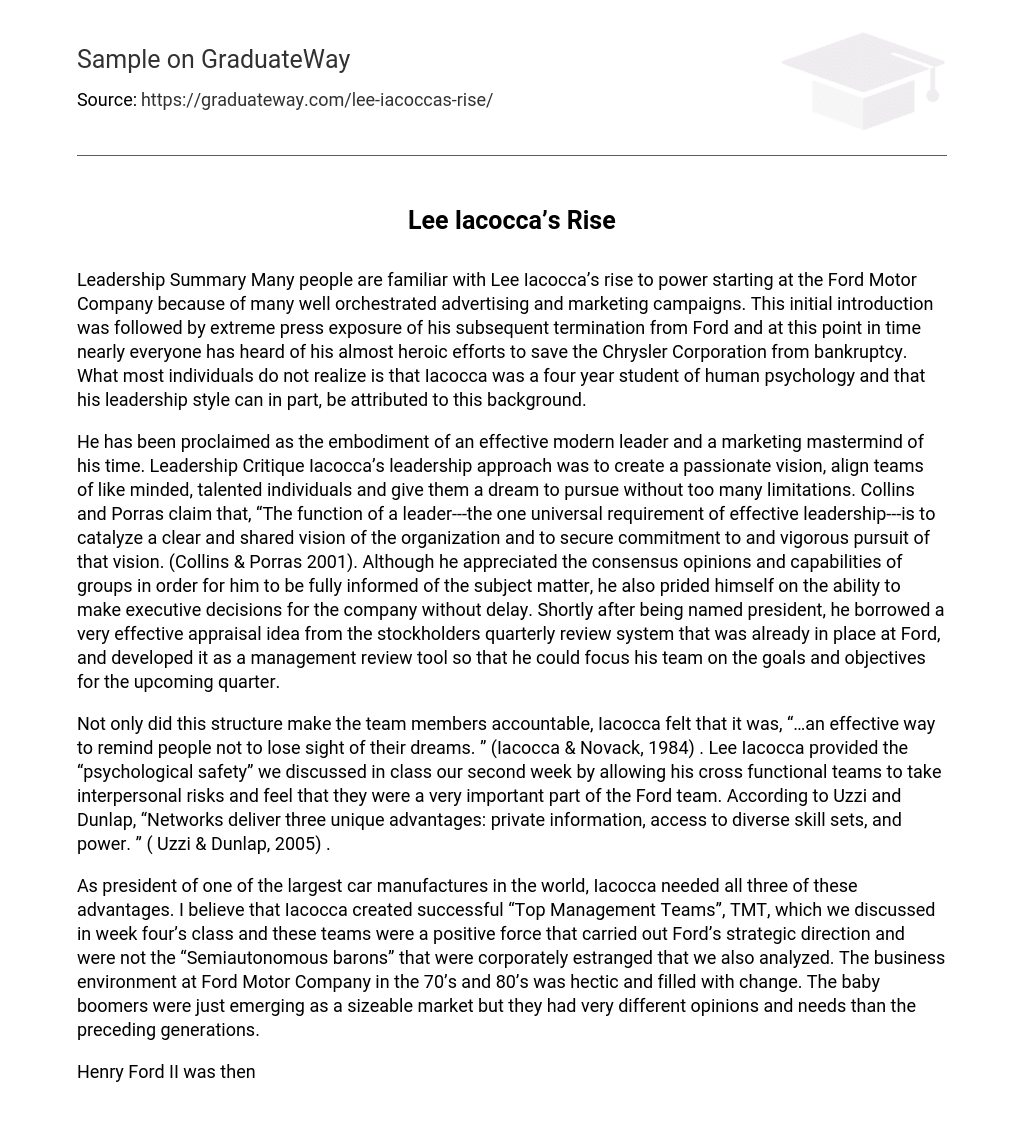Lee Iacocca’s rise to power at the Ford Motor Company is well known due to carefully planned advertising and marketing campaigns. However, his termination from Ford and subsequent efforts to rescue Chrysler from bankruptcy have also garnered significant media attention. What many people may not be aware of is that Iacocca has a background in human psychology, which has influenced his leadership style.
He has been hailed as a highly successful modern leader and a brilliant marketer of his era. Iacocca adopted a leadership approach of creating a passionate vision, assembling teams of talented and like-minded individuals, and empowering them to pursue their dreams with minimal restrictions. According to Collins and Porras (2001), the primary role of a leader is to inspire a clear and shared vision of the organization and foster unwavering commitment towards achieving that vision. While Iacocca valued the collective opinions and capabilities of groups to stay well-informed, he also took pride in his ability to make prompt executive decisions for the company. Soon after assuming the presidency, he incorporated an effective evaluation concept from Ford’s stockholders quarterly review system into a management review tool to facilitate his team’s focus on the objectives and goals for the upcoming quarter.
This structure not only made the team members accountable, but according to Iacocca, it was also an effective way to remind people not to lose sight of their dreams (Iacocca & Novack, 1984). Iacocca provided the psychological safety we discussed in class by allowing his cross functional teams to take interpersonal risks and feel that they were a very important part of the Ford team. According to Uzzi and Dunlap, networks deliver three unique advantages: private information, access to diverse skill sets, and power (Uzzi & Dunlap, 2005).
As president of one of the largest car manufacturers in the world, Iacocca needed to leverage three key advantages. I believe that Iacocca successfully formed “Top Management Teams” (TMT), which we discussed in week four’s class. These teams played a crucial role in implementing Ford’s strategic direction and did not resemble the “Semiautonomous barons” we analyzed before. The business environment at Ford Motor Company in the 70’s and 80’s was characterized by chaos and rapid changes. The emergence of the baby boomers as a significant market brought forth contrasting opinions and needs compared to previous generations.
Henry Ford II, the Chairman and CEO of the company at that time, exhibited an autocratic and conventional leadership style. He exemplified the concept of “managerial leadership” by being highly reactive and determined to maintain traditional operating practices at Ford. In contrast, Lee Iacocca displayed traits of both a managerial leader, by focusing on short and long-term strategies, and a “visionary leader,” as he was willing to take risks and deeply concerned about the future of the auto industry.
Ford II’s decision not to pursue a proactive arrangement with Honda, in which they would have obtained smaller engines from them, hindered their ability to introduce more affordable compact vehicles. Consequently, Ford fell behind in meeting the growing demand for smaller cars, causing them to lose their competitive advantage for a significant period of time. Lee Iacocca, also referred to as “the father of the Mustang,” played a vital role in elevating Ford’s quality from good to exceptional. As a result of his efforts, Iacocca gained widespread recognition and became a well-known household name.
According to my perspective, the Mustang is Iacocca’s greatest Big Hairy Audacious Goal (BHAG), regardless of whether he acknowledged it at that time. This is due to its unique characteristics, market appeal, and pricing which differed greatly from any previous Ford car. His aim was to create a vehicle with a sleek design, strong performance, and an affordable price in order to attract the younger generation of baby boomers and cater to the general public. The success of the Mustang proved his vision right.
References:
Collins, J. C., & Porras, J. I. (2001). Organizational Vision and Visionary Organizations.
Erika Hayes James and Lynn Perry Wooten. (2005). Leadership as (Un)usual: How to Display Competence in Times of Crisis.
Organizational Dynamics, 34(2). Iacocca, L. , & Whitney, C. (2007). Where Have All The Leaders Gone? New York, New York: Scribner.
Iacocca, L. , & Novack, W. (1984). Iacocca: An Autobiography: Lee Iacocca with William Novack. New York, New York: Bantam Books.
Kotter, J. P. (2001). Best of HBR: What Leaders Really DO. Harvard Business Review.
Thomas, T., Schermerhorn Jr., & Dienhart J.W.(2004). Strategic leadership of ethical behavior in Business.Academy of Management Executive,18(No.2).
Uzzi,B.&Dunlap,S.(2005)Managing Yourself:How to Build Your Network.Harvard Business Review.





